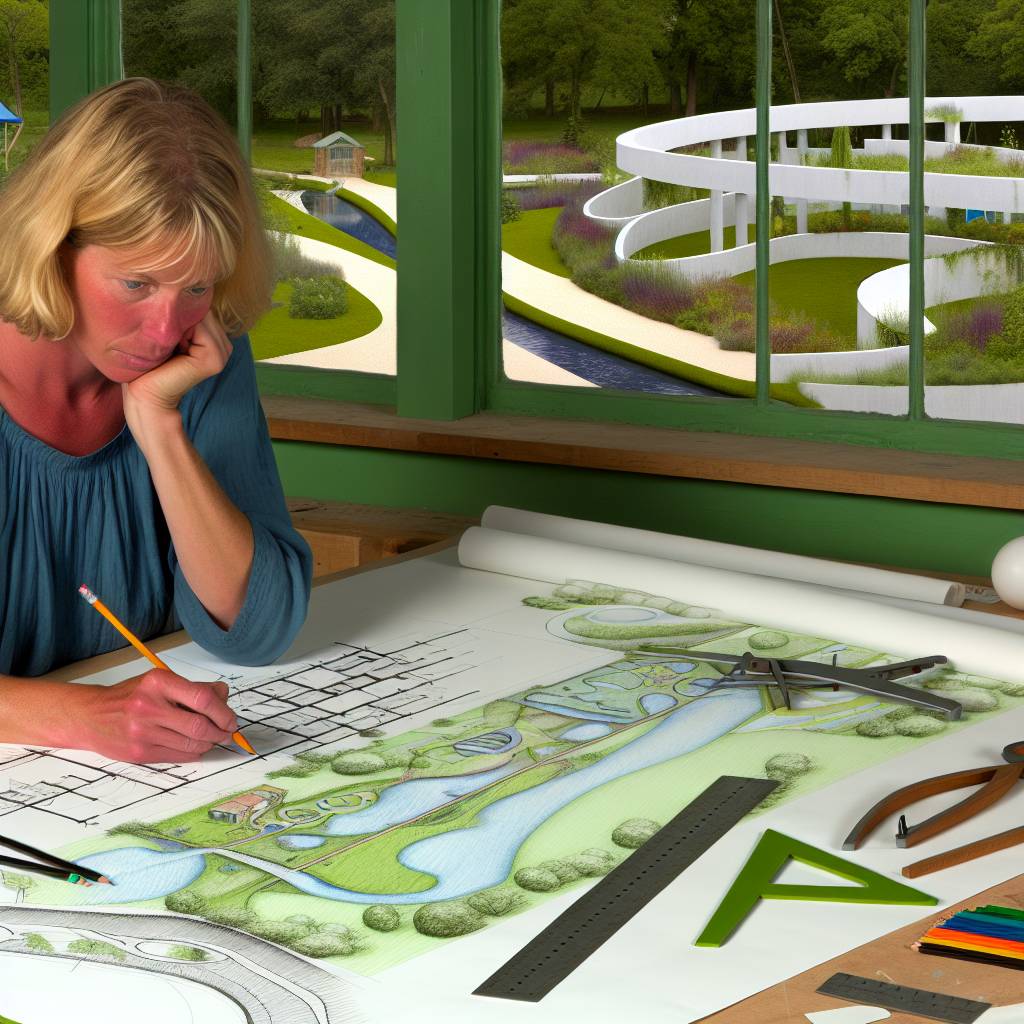Introduction:
Landscape architecture plays a crucial role in shaping our surroundings and enhancing the quality of life.
The field of landscape architecture is experiencing rapid changes and advancements due to technological innovations.
This blog post aims to provide insights into the upcoming trends in landscape architecture for the year 2024.
Emerging Technologies:
In 2024, Artificial Intelligence (AI) and Augmented Reality (AR) will revolutionize landscape design processes.
AI will help designers analyze data to create sustainable and visually appealing landscapes.
AR will allow clients to visualize proposed designs in real-time, enhancing communication and decision-making.
Sustainable Practices:
In response to climate change, landscape architects will focus on implementing sustainable practices in their designs.
Green roofs, rain gardens, and permeable pavements will become standard features to promote environmental conservation.
Native plant species will be prioritized to support biodiversity and reduce maintenance costs.
Wellness Design:
There will be an increasing emphasis on designing landscapes that promote mental and physical well-being.
Therapeutic gardens, stress-reducing elements, and outdoor wellness spaces will be integrated into projects.
Biophilic design principles will be utilized to create connections between humans and nature.
The future of landscape architecture in 2024 holds exciting possibilities with a focus on technology, sustainability, and wellness design.
Technology Integration:
In landscape architecture, technological advancements have significantly transformed the way designers create and visualize projects.
Let’s explore some key aspects:
Virtual Reality and 3D Modeling:
- Virtual reality (VR) and 3D modeling tools have revolutionized the design process, allowing designers to immerse themselves in a digital representation of their projects.
- Designers can now walk through the virtual landscape, experiencing the scale, proportions, and spatial relationships in real-time.
- This technology enables clients to have a clear understanding of the proposed design before any physical construction begins.
Importance of Data Analytics:
- Data analytics play a crucial role in creating sustainable and functional landscape designs.
- By analyzing data related to soil composition, climate conditions, and plant species, designers can make informed decisions that optimize the environmental performance of their projects.
- Using data analytics, designers can also predict how a landscape will evolve over time, allowing for proactive maintenance and management strategies.
- This data-driven approach ensures that landscape designs are not only visually appealing but also ecologically sound and resilient.
Examples of Cutting-Edge Technology:
- One example of cutting-edge technology in landscape architecture is the use of drones for site analysis and surveying.
- Drones can capture detailed aerial images of a site, providing designers with valuable information for their designs.
- Another innovative technology is the use of smart irrigation systems that adjust watering schedules based on real-time weather data, leading to more efficient water use and healthier plant growth.
- Furthermore, advances in materials science have led to the development of sustainable construction materials that reduce the environmental impact of landscape projects while maintaining high aesthetic standards.
The integration of technology in landscape architecture is driving innovation and pushing the boundaries of what is possible in creating sustainable, functional, and aesthetically pleasing outdoor spaces.
Innovative Trends in Landscape Architecture 2024
Sustainable Design Practices
- Emphasis on the use of native plants and green infrastructure
- Discussion on how landscape architects are incorporating renewable energy sources
- Case studies of projects that prioritize environmental conservation and sustainability
As we look ahead to 2024, sustainable design practices are becoming increasingly important in landscape architecture.
Landscape architects are now focusing on incorporating eco-friendly elements into their designs to preserve the environment for future generations.
Emphasis on the Use of Native Plants and Green Infrastructure
One of the key trends in sustainable design practices is the use of native plants and green infrastructure.
Native plants are well-suited to the local climate and require less water and maintenance compared to exotic species.
Transform Your Career Today
Unlock a personalized career strategy that drives real results. Get tailored advice and a roadmap designed just for you.
Start NowBy incorporating native plants into landscape designs, architects can create resilient and biodiverse ecosystems that support local wildlife.
Green infrastructure, such as rain gardens, green roofs, and permeable pavements, is another aspect of sustainable design that landscape architects are embracing.
These elements help manage stormwater runoff, reduce heat island effects, and improve air quality.
By integrating green infrastructure into their projects, landscape architects can mitigate the adverse effects of urbanization on the environment.
Discussion on How Landscape Architects are Incorporating Renewable Energy Sources
In addition to using native plants and green infrastructure, landscape architects are exploring ways to incorporate renewable energy sources into their designs.
Solar panels, wind turbines, and geothermal heating systems are now being integrated into landscape projects to reduce energy consumption and promote sustainability.
By harnessing the power of renewable energy, landscape architects can create environmentally-friendly spaces that contribute to a greener future.
Case Studies of Projects that Prioritize Environmental Conservation and Sustainability
Many landscape architecture projects are now prioritizing environmental conservation and sustainability.
For example, the High Line in New York City is a successful case study of how an abandoned railway was transformed into a vibrant urban park that promotes biodiversity and sustainability.
The use of native plantings, green infrastructure, and recycled materials has made the High Line a model for sustainable landscape design.
Sustainable design practices are shaping the future of landscape architecture in 2024.
By emphasizing the use of native plants, green infrastructure, and renewable energy sources, landscape architects are creating eco-friendly spaces that prioritize environmental conservation and sustainability.
Through innovative approaches and careful planning, landscape architects are making significant strides towards a more sustainable and resilient built environment.
Uncover the Details: Understanding Overtime Rules for Dockworkers
Urban Agriculture and Foodscaping:
Urban agriculture is a growing trend in landscape architecture that involves integrating food production into urban landscapes.
This practice not only adds greenery to cities but also provides numerous benefits in terms of health, community engagement, and sustainability.
Benefits of Foodscaping:
- Improving access to fresh, locally-grown produce
- Promoting healthy eating habits and active lifestyles
- Reducing carbon footprint by sourcing food locally
- Creating opportunities for community engagement and education
- Enhancing biodiversity and urban ecosystem resilience
Examples of Successful Urban Agriculture Projects Around the World:
- Brooklyn Grange (New York City, USA): Rooftop farms producing organic vegetables
- Seoullo 7017 (Seoul, South Korea): Elevated urban park with edible plants
- Incredible Edible (Todmorden, UK): Community-led initiative to grow food in public spaces
- Parque Portales (Santiago, Chile): Urban orchard providing fresh fruit to local residents
- City Farmers (Sydney, Australia): Community garden promoting sustainable food production
Urban agriculture and foodscaping not only contribute to the aesthetics of urban landscapes but also play a vital role in promoting a healthier and more sustainable way of living.
By incorporating food production into city planning, landscape architects can create vibrant and resilient communities that prioritize food security, environmental stewardship, and community well-being.
Discover More: Environmental Impact of Lumberjack Work
Showcase Your Business Today
Reach thousands of readers actively exploring professional services. Publish your business profile and grow your audience now.
Publish NowClimate Change Resilience:
Designing landscapes that can withstand climate change impacts is crucial for the future.
Here are some strategies for managing water and mitigating heat in urban areas:
- Implement green infrastructure such as rain gardens and permeable pavement to manage stormwater runoff.
- Integrate green roofs and walls to reduce the urban heat island effect and increase cooling.
- Utilize strategic tree planting to provide shade, improve air quality, and reduce heat stress.
Creating resilient landscapes in the face of environmental challenges requires innovative solutions:
- Explore the use of native and drought-tolerant plants to reduce water consumption and maintenance needs.
- Adopt sustainable drainage systems to manage flood risk and improve water quality in urban areas.
- Incorporate adaptive design strategies that allow landscapes to evolve and respond to changing climate conditions.
By incorporating these strategies and solutions, landscape architects can play a significant role in addressing climate change and creating sustainable, resilient environments for future generations.
Explore Further: Effective Waste Disposal Methods in Construction
Biophilic Design:
Biophilic design is the concept of integrating nature into the built environment to enhance human connection to nature.
- Landscape architects are incorporating biophilic principles by using natural materials like wood and stone in their designs.
- They also create green spaces within urban areas, such as rooftop gardens, to bring nature closer to city dwellers.
- Biophilic design has been shown to reduce stress, improve cognitive function, and enhance overall well-being in urban settings.
- By incorporating elements like natural light, plants, and water features, landscape architects can create a more harmonious and healthy environment.
- Studies have found that exposure to nature in urban settings can lead to increased productivity, creativity, and a sense of tranquility.
Biophilic design offers a holistic approach to creating sustainable and resilient landscapes that benefit both humans and the environment.
Discover More: Assembler Salary Expectations and Benefits

Modular and Flexible Design
Modular design in landscape architecture involves creating elements that are built in separate sections.
This approach allows for greater flexibility in design and implementation.
Advantages of flexibility in design for changing urban environments include:
- Ability to adapt to evolving needs and trends.
- Improved resilience to extreme weather events.
- Opportunity for experimentation and innovation.
- Enhanced sustainability through reuse and repurposing.
Projects that utilize modular elements to create versatile and adaptable landscapes:
- The High Line in New York City: This elevated linear park incorporates modular seating, planters, and lighting fixtures that can be easily reconfigured to accommodate different events and activities.
- The Vancouver Convention Centre West: The green roof of this convention center features modular planting beds that can be moved around to create different configurations and patterns, adding visual interest and flexibility to the space.
- The Ørestad District in Copenhagen: This mixed-use neighborhood includes modular outdoor furniture and play equipment that can be rearranged to meet the changing needs of residents and visitors, promoting social interaction and community engagement.
By embracing modular and flexible design principles, landscape architects can create dynamic and resilient environments.
These environments respond to the evolving needs of urban spaces.
One of the significant aspects in Landscape Architecture in 2024 is the emphasis on Cultural and Social Equity.
It is crucial to create inclusive and diverse landscapes that reflect different cultures.
Addressing the Importance of Cultural Diversity:
- By incorporating elements from various cultures, landscape architects can create spaces where everyone feels represented and valued.
- Celebrating cultural diversity through design helps break down barriers and fosters a sense of unity among different communities.
- By acknowledging and respecting cultural differences, landscape architects can promote understanding and appreciation among diverse groups.
Role of Landscape Architects in Fostering Social Equity:
- Landscape architects play a crucial role in promoting social equity by designing spaces that are accessible and inclusive for all individuals.
- By considering the needs of marginalized communities, landscape architects can create environments that promote social justice and equality.
- Through thoughtful design interventions, landscape architects can contribute to the empowerment and well-being of communities facing social challenges.
Showcasing Projects with Community Engagement and Cultural Sensitivity:
- Highlighting projects that prioritize community engagement and cultural sensitivity can inspire other landscape architects to follow suit.
- Projects that involve local community members in the design process tend to have a stronger sense of ownership and authenticity.
- By collaborating with stakeholders from diverse backgrounds, landscape architects can create spaces that resonate with a wide range of users.
Cultural and Social Equity are integral components of modern Landscape Architecture.
By embracing diversity, promoting social justice, and engaging with communities, landscape architects can create meaningful and impactful designs that enrich the lives of all individuals.
As we look towards the future of landscape architecture in 2024, several key innovative trends are shaping the industry.
From advancements in technology to a renewed focus on sustainability, landscape architects are embracing new ways to design and create outdoor spaces.
One major trend is the integration of smart technology into landscape design.
This includes features such as automated irrigation systems, LED lighting, and interactive elements that enhance the overall experience of outdoor spaces.
Another important trend is the emphasis on sustainability and resilience in landscape architecture.
Designers are increasingly incorporating native plants, green infrastructure, and water conservation techniques to create environmentally friendly and climate-responsive landscapes.
Landscape architects play a crucial role in driving positive change and promoting the development of healthy and vibrant outdoor environments.
Their expertise in design, planning, and project management helps create spaces that enrich communities and improve quality of life.
As we move forward, it is essential for readers to stay informed and inspired by the ongoing developments in the field of landscape architecture.
By following the latest trends and innovations, we can all contribute to the creation of more sustainable, resilient, and enjoyable outdoor spaces.
Additional Resources
Shifting Priorities, Passion-driven Living, And Wellness And …




